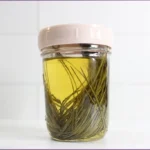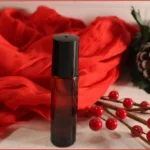When reading any article related to aromatherapy topical application or DIY skincare, you’ll likely come across the terms ‘essential oils’ and ‘carrier oils’.
At first, they might sound like the same thing – both are natural plant-based oils used in blends, scrubs, soaps, and self-care recipes. However, despite a few similar characteristics, these two types of oils couldn’t be more different.
Carrier oils are mild, nourishing bases that can be applied to the skin on their own. Essential oils, on the other hand, are aromatic, highly concentrated, and cannot be applied to the skin on their own.
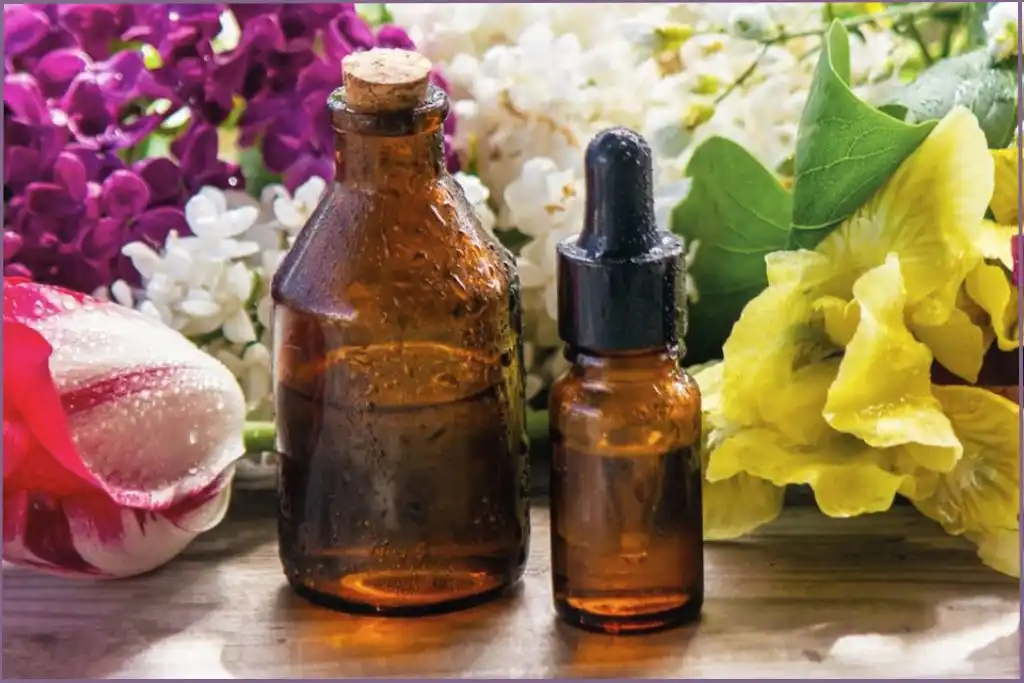
✨ Get 12 Free Holiday Diffuser Blends — Printable PDF
Instantly make your home smell like Christmas with these festive, ready-to-use recipes.
In this guide on essential oils vs carrier oils, we’ll walk through the differences between these two oils.
Knowing what sets them apart, what each one does, and how they work together makes your aromatherapy experience safer and more enjoyable.
Table of Contents
Affiliate Disclosure: Some links on this site are affiliate links. I may earn a small commission if you purchase through them, at no extra cost to you. See the full affiliate disclosure.
What Are Essential Oils?

The heart and soul of aromatherapy, essential oils are concentrated plant extracts obtained using methods such as steam distillation or cold pressing.
They contain the natural aroma and “essence” of the plant they are extracted from, which is why they are so strongly scented.
A single drop of essential oil can be incredibly potent, holding the concentrated fragrance compounds of various botanical parts such as flowers, leaves, bark, or citrus peels.
Unlike carrier oils, essential oils are volatile, meaning they evaporate quickly and don’t leave behind a greasy texture.
Because they’re so highly concentrated, essential oils are not meant to be applied directly to the skin. Instead, they’re diluted with a carrier oil before topical use to minimize the risk of skin irritation.
Common examples of essential oils:
Lavender – Soft, floral, and relaxing
Peppermint – Cool, refreshing, and invigorating
Sweet Orange – Bright, cheerful, and citrusy
Essential oils are often used in different types of diffusers. They are also used to scent candles, soaps, and sugar scrubs, or create customized blends for selfcare rituals.
What Are Carrier Oils?

Carrier oils are mild, plant-based oils obtained from nuts, seeds, or kernels.
Unlike essential oils, carrier oils are not aromatic or volatile. Instead, they are rich in nutrients, fatty acids, and moisturizing properties, which makes them the perfect base for diluting essential oils.
The name “carrier oil” comes from their role in carrying essential oils safely onto the skin. Without them, essential oils would be far too strong and could irritate the skin.
Carrier oils also slow down the evaporation of essential oils, allowing the scent to last longer and the blend to spread more evenly.
Popular carrier oils include:
Coconut – Lightweight, deeply moisturizing
Jojoba – Skin-friendly, closely resembles natural sebum
Sweet Almond – Smooth, mild, and great for massage blends
Carrier oils are used in body scrubs, lotions, balms, and other skincare products to dilute the strength of essential oils and also nourish the skin.
Here’s a more detailed look at the differences between essential oils and carrier oils.
Table Highlighting Key Differences Between Essential Oils And Carrier Oils
| Feature | Essential Oils | Carrier Oils |
| Source | Extracted from flowers, leaves, bark, or peels through distillation or cold pressing | Cold-pressed from nuts, seeds, or kernels |
| Concentration | Highly concentrated & aromatic | Mild, nourishing, & gentle |
| Texture | Volatile, evaporates quickly, non-greasy | Non-volatile, moisturizing, oily texture |
| Primary Role | Provides fragrance and plant essence | Dilutes and “carries” essential oils for safe use |
| Application | Never applied directly to skin (requires dilution) | Never applied directly to the skin (requires dilution) |
| Examples | Lavender, Peppermint, Tea Tree, Sweet Orange | Coconut, Jojoba, Sweet Almond, Grapeseed |
Essential Oils Vs Carrier Oils: Origin and Extraction Process
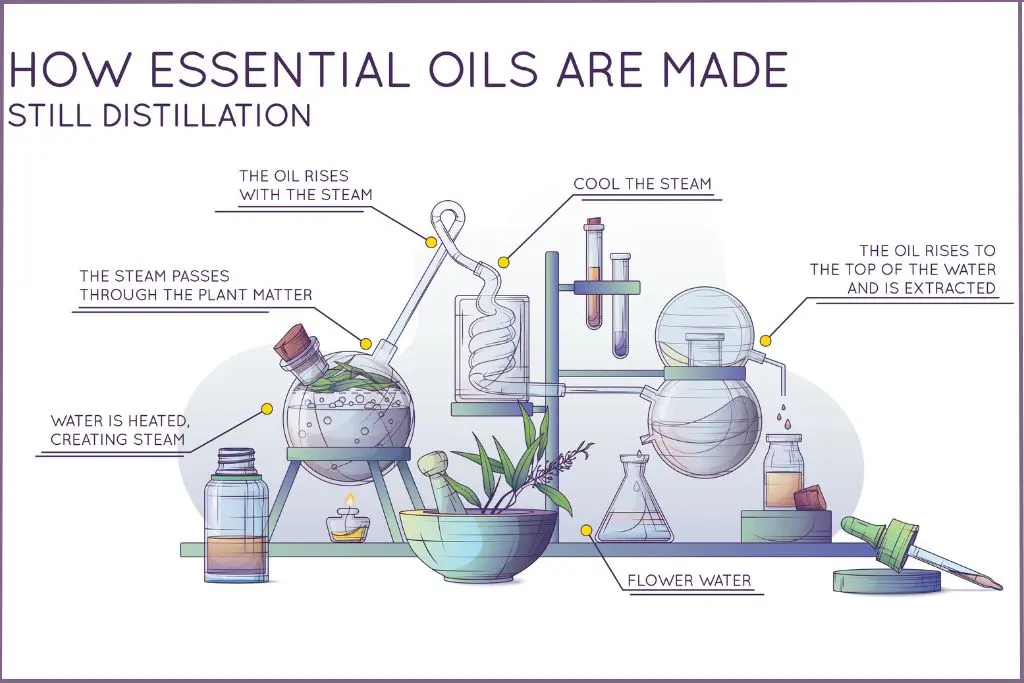
The first big difference starts at the source.
Essential oils and carrier oils not only come from different parts of plants, but the way they’re made is always different. Their origin and extraction process also shape their use and quality.
Essential oils are extracted from various plant parts, including flowers, leaves, bark, or fruit peels. Steam distillation and cold pressing are two of the most common techniques used to extract these oils. Both methods aim for purity, focusing on capturing the plant’s most powerful scent compounds. These processes use a lot of plant material to extract a small amount of pure, concentrated oil.
Carrier oils are obtained from the seeds, nuts, or kernels of plants. They’re usually obtained through cold pressing or expeller pressing, which uses friction to press out the oil. These methods preserve nutrients and natural properties, resulting in a mild, nourishing oil that is perfect for the skin.
The extraction process matters because it affects the final use, safety, and benefits of the oils you choose.
Essential Oils Vs Carrier Oils: Scent Profiles and Concentration
The scent profile is the most noticeable difference between essential oils and carrier oils.
Essential oils pack a punch with their scent. They’re made up of highly concentrated and volatile (easy-to-evaporate) compounds. That’s why even a drop can fill a room with fragrance or carry the “personality” of the plant. They’re too strong to use directly on skin, which is why they must be diluted with a carrier oil for topical application.
Carrier oils may be odorless or have very mild scents. Instead of grabbing attention, they act as a soft backdrop, letting essential oil aromas stand out. Carrier oils are gentle, and their low scent means they blend in easily, never overpowering the mix.
In short:
Essential oils = Strong, intense, and noticeable aroma.
Carrier oils = Soft, nearly neutral, and subtle scent.
Common Ways To Use Essential Oils Vs Carrier Oils
These are some of the ways to use essential oils safely and enjoyably:
- Aromatherapy and Diffusers: Add a few drops to a diffuser to scent your space.
- DIY Body Oils: Mix with a carrier oil to create custom body oils or massage blends.
- Bath Rituals: There are many ways to use essential oils in the bath.
- Home Cleaning Routines: Add a few drops to cleaning solutions for a fresh, natural scent.
This list of essential oil uses with a scannable table is a handy guide to using the right essential oils for the right purpose.
These are some common situations where carrier oils shine:
- Essential oil dilution: Always dilute essential oils before applying to your skin. Carrier oils make this step smooth and enjoyable.
- Massage blends: Use alone or with added scents for a relaxing massage experience.
- Bath and body products: Carrier oils enrich homemade scrubs, lotions, and bath soaks.
Whether you’re making a quick roller blend for stress relief or mixing up a rich body oil for use after your shower, understanding the role of carrier oils helps every project turn out better and safer.
Essential Oils Vs Carrier Oils: Roles in Topical Application
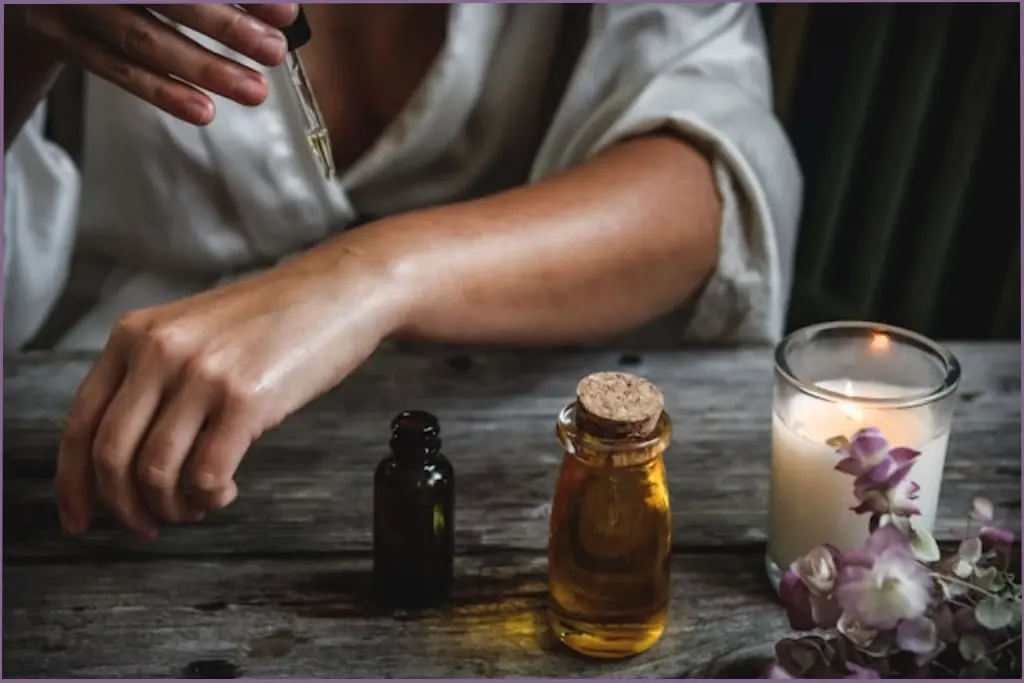
Both oils shine brightest when they work together, but how you use each one is very different.
Essential oils are almost always used in small doses – you only need a few drops to enjoy their aroma. Their main functions include adding fragrance, setting a mood, or providing a signature scent in a blend. On their own, they can be too much for the skin and even cause irritation if used undiluted.
Carrier oils step in as the safe carrier for these powerhouses. Their job is to dilute essential oils and make them comfortable for skin contact, massage, or hair treatments. They help essential oils spread and absorb slowly, offering more moisture and less risk of side effects.
Here’s a quick bullet list that sums up the roles of essential oils and carrier oils in topical applications:
Essential oils:
- Used for aroma, mood, or special scent blends
- Must be diluted before using on skin
- Potent and often sold in small bottles
Carrier oils:
- Used to dilute essential oils and make custom blends safe
- Work well as standalone moisturizers
- Come in larger bottles and can be used generously
Blending both types of oils brings out the best in each. You get the safe, skin-friendly moisture from carrier oils and the bold scent from essential oils, all in one simple mix.
How to Use Essential Oils and Carrier Oils Together
Combining essential oils with carrier oils opens up a world of feel-good wellness routines.
The carrier oil acts as a cushion for your skin, making powerful plant aromas gentle enough for everyday use.
Blending the two allows you to create oils for massage, homemade skincare, or a relaxing bedtime ritual tailored just for you.
Here’s how beginners can get started blending safely and easily.
Deciding When To Use Essential Oils Vs Carrier Oils
Carrier oils set the stage for essential oils to shine. Choosing between them depends on your needs:
Essential oils: Ideal when you want a powerful scent or specific plant benefit.
Carrier oils: Best for moisturizing, massage, or gentle skin care. These are also essential when you plan to use essential oils on your skin.
Tips for Blending and Application
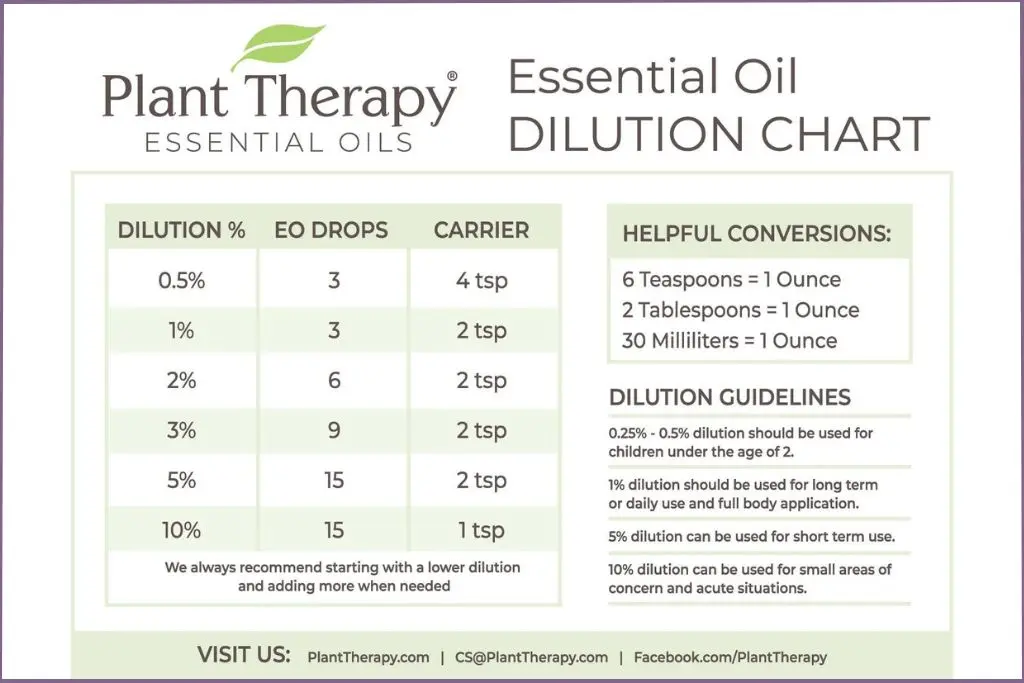
Getting the most out of essential and carrier oils is all about smart mixing and thoughtful application.
Keep these key tips in mind for blending for massage, skincare, and relaxation:
For Massage
Start with the right base: Choose a carrier oil with good slip, like sweet almond or grapeseed. These spread well without leaving a heavy film.
Dilute correctly: For adults, a common ratio is 5–10 drops of essential oil in 1 ounce (about 30 ml) of carrier oil. Always use a lower concentration if you have sensitive skin.
Pick your aroma: Lavender, eucalyptus, and peppermint are favorites for tension relief and uplift during massage.
For Skincare
Go light: For facial use, pick gentle carrier oils such as jojoba or argan. These are less likely to clog pores.
Scan your essential oils: Some oils help with specific skin goals. Tea tree is great for clarity, while frankincense can help with glow.
Use correct dilutions: Use 2-3 drops of essential oil per tablespoon of carrier oil for face blends. For body use, you can add a few more drops.
Patch test: Always dab a small amount on your inner arm first to check for sensitivity.
There’s more than one way to get the benefits of essential oils for your skin.
For Relaxation
Create easy roll-ons: Mix calming oils like lavender or chamomile with a light carrier (such as fractionated coconut oil) in a roller bottle. Swipe onto wrists and neck at bedtime.
Soak it in: Add a pre-blended mix to warm bath water for a fragrant soak. Try 5–10 drops of essential oil in a tablespoon of carrier oil, stir in, and enjoy a spa-like bath.
Diffuse with a boost: While diffusers only need essential oils, keep a diluted blend on hand to massage into temples or the back of your neck for extra comfort during meditation or yoga.
Essential oils and carrier oils may sound similar, but they play very different roles in aromatherapy and DIY projects.
Understanding the roles of essential oils vs carrier oils gives every beginner a boost of confidence.
Essential oils provide the concentrated aroma and plant essence, while carrier oils make them safe and practical to use on the skin.
When combined, these two types of plant oils balance each other perfectly, bringing together fragrance, nourishment, and safety in every blend.
Experiment with different combinations to see what you enjoy most – your preferences will guide you to routines that feel personal and rewarding.
For extra inspiration, the Essential Oil Accessories Overview offers ideas for tools and add-ons that can make blending and using oils even easier.
FAQs About Carrier Oils Vs Essential Oils

Can I use essential oils directly on my skin without a carrier oil?
No. Essential oils are highly concentrated and must always be diluted with a carrier oil before applying to the skin. The only exception is when they’re used in a diffuser, where dilution isn’t required.
Do carrier oils have a scent?
Some carrier oils, like jojoba or fractionated coconut oil, are almost odorless, while others have a light, nutty, or earthy aroma. Usually, the scent is so subtle that it won’t overpower essential oils in a blend.
Can I mix different carrier oils together?
Yes. Blending carrier oils is a great way to customize texture and absorption. For example, mixing coconut oil with jojoba creates a balance between deep nourishment and light absorption.



